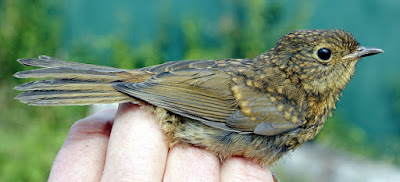This morning I went along to Andy’s local patch and joined him for a ringing session.
Marton Mere is a mere (lake) and Local Nature Reserve in Blackpool, Lancashire. It is recognised as a Site of Special Scientific Interest (1979) and supports various habitats such as open water, reed beds and grassland as well as pockets of woodland and scrub. The area provides home to a good variety of birds both resident and migratory. Over the years the mere and its surrounds has turned up a good number of rare birds including American Bittern, Whiskered Tern, Short-billed Dowitcher, Hoopoe, Barred Warbler, Little Bittern, Wryneck and Savi’s Warbler. In doing so the mere attracts good numbers of bird watchers and twitchers hoping to see the current or next rarity.
Marton Mere - geograph.org.uk
Our focus this morning was on catching resident birds and where possible proving breeding. The mere went for many, many years with no breeding bird surveys or bird ringing on which to formulate an environmental management programme for the area - a sad state of affairs.
In very recent years, and thanks to the cooperation of Blackpool Borough Council, Andy has been allowed and encouraged to undertake a bird ringing project in a small and secure area.
We spent 5 hours there this morning during which we caught 44 birds of 14 species including a good number of warblers. As we might expect in early July, all of the species we caught were either in breeding condition as adults or recently fledged local juveniles.
Totals - 17 Reed Warbler, 6 Blue Tit, 5 Whitethroat, 3 Sedge Warbler, 2 Cetti’s Warbler, 2 Blackcap, 2 Dunnock, 2 Robin, 1 Blackbird, 1 Song Thrush, 1 Chiffchaff , 1 Treecreeper, 1 Reed Bunting.
The phragmites reed is now very extensive and now good enough to hold many pairs of Reed Warbler and even regular wintering Bitterns and sometimes, Bearded Tits.
We work just a small area of the reed perimeter so our catch of 11 new Reed Warblers and 6 recaptures from 3 weeks ago was very worthwhile.
Reed Warbler - first year/juvenile
Cetti’s Warblers first appeared at Marton Mere in the early 1970’s following their colonisation of the southern England in the 1960’s. Because Cetti’s Warbler is very elusive, more regularly heard than seen, breeding is difficult to prove. Today we caught a female with a good sized brood patch and so in in breeding condition. The juvenile was not noticeably young but clearly a local bird, and by now the female could be on with a second set of eggs.
Cetti's Warbler - first year/juvenile
Just three Sedge Warblers caught - all adults. The area we worked is not absolutely suited to Sedge Warbler, added to which, habitat changes in recent years across the whole site have caused the species to decline since the 1990’s.
Sedge Warbler - adult
A Chiffchaff sung all around us most of the morning so it was not a surprise to find that we caught it.
Chiffchaff - adult male
The Whitethroat is another species to have suffered an on-site decline due to habitat changes with species being somewhat replaced by the Blackcap, a more strictly woodland bird. The Robin is a species of mainly woodland, the Treecreeper almost exclusively so, and a species unheard of at Marton Mere in the past.
Blackcap - female
Whitethroat - first year/juvenile
Whitethroat - first year/juvenile
Robin - first year/juvenile
Treecreeper - first year/juvenile
Forty five little brown jobs kept us pretty much occupied with little or no opportunity for birding, but other species noted included Sparrowhawk, Grasshopper Warbler, Common Tern and Goldfinch.
Linking today to Eileen's Saturday.
Linking today to Eileen's Saturday.






































9 comments:
Sounds like a great day of banding, Phil, with a pleasing variety of species.
We have only three nests of our first round of Barn Swallows to band, and will be doing that on Saturday morning. Eight nests (as of Monday) already have second clutches, however, so there will be more activity to come. And we will resume general mist netting around mid August. There is so much activity in my backyard these days I could profitably set up a net there!
You are so blessed, Phil! I don't even get to see many of these birds, let alone touch them! Beautiful!
Must be great to have breeding Cettis Warbler there these days...........
I see this is very interesting place to birding and ringing. This young Robin looks beautiful :).
That sounded lijke a good ay's ringing to me. Great shots
Hi Phil, Sounds like you had a great day of ringing. The birds and photos are all beautiful. The nature reserve looks beautiful too. Thank you for linking up and sharing your post. Happy Saturday, enjoy your weekend!
Very sweet birds,
Great photos!
Some of the birds look happy to be the center of attention, others not so much
Have a wonderful week-end!
do you have a favorite bird to watch for ?/I like the spiky legged shore birds but love them all and feed many esp sandhill cranes
Post a Comment